For many new businesses, Instagram can feel like a fast-moving train that’s hard to jump onto. You’ve seen the success stories. You’ve heard about the engagement. But turning that potential into real results takes more than just running a few ads.
To succeed, you need a clear, actionable Instagram ads strategy. One built on realistic goals, smart targeting, compelling content, and steady testing.
This guide walks you through exactly how to set that up.
Why Instagram Ads Still Matter in 2025
IInstagram continues to be one of the best platforms for brand discovery and customer engagement. With around 2 billion users, it offers a huge opportunity for visibility.
Most importantly, people come to Instagram ready to shop. Over 60% of users say they use it to discover new products, and nearly one-third have made purchases directly through the app.
It also supports high engagement through creative formats like Reels and carousels, which often perform better than static posts. Plus, more Gen Z users now expect brands to respond to questions or issues directly through DMs.
Here’s why Instagram still matters for new businesses:
-
Large and active user base,
-
High product discovery and in-app purchase rates,
-
Strong performance from video and carousel formats,
-
Built-in tools for direct customer interaction.
For small and growing brands, Instagram offers both reach and results. The key is building a strategy that connects the two.
Step 1: Define Clear Goals Before You Start Spending
One of the most common mistakes small businesses make with Instagram ads is launching campaigns without a specific goal. Without a goal, there's no way to measure success. There is also no real direction for your creative, targeting, or budget.
Before you touch Ads Manager, decide what you want the campaign to do. A goal should be focused and measurable. For example, if you’re launching a product, your goal might be to get 1,000 visitors to your landing page within two weeks. If you’re trying to build your brand, maybe you’re aiming for 50,000 impressions in your local market.
Some common campaign goals include:
-
Brand awareness: Getting your business in front of new eyes who haven’t heard of you before.
-
Traffic: Driving visitors to a website, landing page, or storefront.
-
Leads: Collecting emails, sign-ups, or other contact information.
-
Sales: Generating sales or bookings from interested users.
-
Engagement: Encouraging likes, shares, and comments on your posts or videos.
Once you choose your objective, make sure your ad creative, audience, and metrics are aligned with that goal. Too many campaigns fail because the pieces don’t work together.
If you’re not sure how to match your ad type with your business objective, check out our guide on Meta Ad Campaign Objectives Explained. It walks through each goal and how to choose the right one for your campaign.
Step 2: Learn Who You’re Really Selling To
You can’t advertise to “everyone.” Not effectively, anyway. Instagram ads perform best when they speak to a very specific audience, using language, visuals, and offers that match their needs and values.
Start by thinking about your ideal customer. This goes beyond basic demographic info. What you want is a snapshot of their mindset, habits, and motivations.
Ask yourself:
-
What problem are they trying to solve?
-
What other brands or influencers do they follow?
-
What do they care about, fear, or aspire to?
-
What kind of content catches their attention?
Let’s say you own a small brand selling eco-friendly skincare. Your audience might include women aged 25 to 40, but that’s just the beginning. More importantly, they may be interested in cruelty-free products, natural ingredients, and clean beauty routines. They might follow yoga instructors, nutrition experts, or sustainable living blogs.
This is where Meta’s targeting tools really shine. Once you understand your customer’s behavior, you can use:
-
Interest-based targeting: Choose categories like “natural skincare,” “sustainable living,” or “vegan beauty.”
-
Custom audiences: Retarget users who have visited your site, watched your videos, or interacted with your Instagram profile.
-
Lookalike audiences: Reach people who resemble your existing customers or followers.
Better targeting means fewer wasted impressions and more results for your ad spend.
For a detailed process to identify and define your audience, use our step-by-step guide to defining a target audience.
Step 3: Create Ads That Your Audience Will Like
Instagram is a visual-first platform. If your ad doesn’t grab attention in the first few seconds, you’ve already lost the battle.
The best-performing ads aren’t always the ones with the highest production value. In fact, native-looking, real-world content often outperforms traditional ads. Users are more likely to trust something that looks like a regular post rather than a hard sell.
Here’s what makes an ad stand out:
-
Strong visuals: Use high-quality images or short videos that feel organic to the Instagram feed. Bright colors, human faces, and product-in-use shots often work well.
-
A clear hook: Start with a question, statement, or visual that grabs attention immediately. Think of it like a headline for your content.
-
A defined message: What do you want the viewer to learn or feel? Make it obvious. Do not assume they’ll figure it out.
-
A call to action: Always include a CTA that matches your goal. Phrases like “Shop now,” “Sign up,” or “Watch more” are direct and effective.
Don’t be afraid to experiment with different formats. Reels are great for reach and storytelling. Carousels work well for showing product features or step-by-step processes. Stories can be used for time-sensitive offers or quick promos.
No matter the format, make sure your ad feels relevant and relatable to your audience.
Step 4: Test, Learn, and Adjust
One of the biggest advantages of Instagram ads is the ability to track performance in real time. But that only helps if you're actively reviewing your campaigns and making adjustments based on data.
Start by testing small variations in your ads. For example, you might run two versions of the same ad, one with a product image and another with a customer review video. Keep everything else the same. After a few days, you’ll know which creative performs better.
Key metrics to monitor include:
-
Click-through rate (CTR): Are people engaging with your ad?
-
Cost per click (CPC): How much are you paying for each visitor?
-
Conversion rate: Are those visitors taking the action you want?
-
Return on ad spend (ROAS): Are you earning more than you're spending?
If an ad isn’t working, don’t just pause it. Look at why. Is your headline unclear? Is the landing page slow? Are you targeting the wrong audience?
Refining your strategy takes time. Small changes can lead to big improvements.
Step 5: Manage Your Ad Budget Like a Pro
You don’t need a huge budget to see success with Instagram ads. But you do need to spend wisely.
For most new businesses, it’s smart to start small and scale up. This gives you room to test without burning through your entire budget on unproven campaigns.
A good starter strategy might look like this:
-
Begin with a daily budget of $10 to $20 per ad set.
-
Run campaigns for 5 to 7 days to gather data.
-
Pause low-performing ads quickly and reallocate budget to better performers.
-
Increase budget by no more than 20 to 30 percent at a time to maintain consistency.
Always leave a portion of your budget for testing new creatives, formats, or audiences. Instagram is constantly evolving. What worked last month might not work this month.
The goal is not just to spend. It is to spend efficiently and with purpose.
Step 6: Strengthen Your Profile to Support Your Ads
A great Instagram ad can bring someone to your profile. But if your content looks weak or inconsistent, they won’t stick around.
Your profile is part of your conversion funnel. Treat it like a landing page.
Make sure you:
-
Have a clear and professional profile picture and bio.
-
Pin high-performing or informative posts at the top of your grid.
-
Highlight key information in Stories, such as FAQs, reviews, or shipping details.
-
Post regularly with a consistent tone and brand aesthetic.
-
Engage with comments and messages quickly to build trust.
The more confident people feel after clicking your ad, the more likely they are to buy or follow.
Want more ideas for high-converting content? Here’s our list of the best AI text and image generators you can use to create Instagram ads and posts that stand out.
Closing Thoughts
A strong Instagram ads strategy for new businesses doesn’t have to be overwhelming. It’s about building a process, setting clear goals, understanding your audience, creating content that resonates, and optimizing over time.
If you treat Instagram as a place to learn and grow, not just a place to sell, you’ll see better performance, stronger customer relationships, and more sustainable growth.

